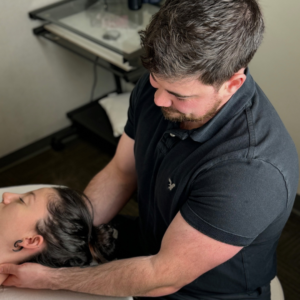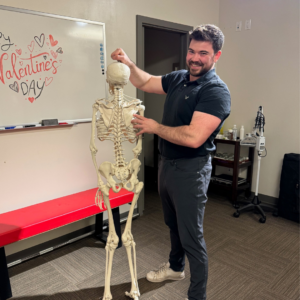Shoulder Pain, Dysfunction, and How to Get Better
When challenged with pain or difficulty moving your shoulder, the impacts can be profound. You may find yourself with a mild irritation reaching for a glass on a high shelf, or having too much pain to perform in sport, or even unable to move your arm at all. Wherever you find yourself now, a common main concern is the issue becoming worse.
Massage offers an effective approach to improving dysfunction, range of motion and reducing pain, across the musculoskeletal system. When dealing with shoulder issues it can be especially helpful to start with manual therapy to get the ball rolling in your recovery, and follow through with exercises tailored to your level of ability that will help improve your quality of movement and increase your confidence in your capabilities.
In massage therapy sessions for treating shoulder and neck conditions, techniques such as soft tissue myofascial release can be utilized to specifically target areas of tension and restriction in the muscles and connective tissue of the shoulder, upper back and neck region. The goal is to promote relaxation, improve circulation, and restore optimal function to the affected area.
No one wants their mild irritation to progress to being unable to move their shoulder! The good news is there are things that can help with shoulder mobility, stability, and pain. One of the things I have seen that has been most successful is appropriate load bearing and mobility exercises. When these exercises are performed in appropriate range, intensity, and frequencies, they can go a long way towards improving outcomes surrounding shoulder dysfunction. Continue reading as we dive deeper into this topic!
Understanding Your Shoulder Symptoms:
Here is a simplified list of common shoulder range of motion (ROM), repetitive strain injuries (RSIs), and painful conditions that often respond well to massage therapy, including techniques like soft tissue myofascial release and joint mobilization all within the scope of practice of a REgistered Massage Therapist.
- Frozen Shoulder (Adhesive Capsulitis): A condition where the shoulder joint becomes stiff and painful, limiting range of motion. Massage therapy can help improve flexibility and reduce pain by loosening tight muscles and connective tissue around the shoulder joint.
- Rotator Cuff Tendonitis: Inflammation of the tendons in the rotator cuff, causing pain and restricted movement. Massage therapy can alleviate pain and improve mobility by reducing inflammation and releasing tension in the muscles surrounding the shoulder.
- Shoulder Impingement Syndrome: Occurs when the tendons of the rotator cuff muscles become irritated and inflamed as they pass through the shoulder joint. Massage therapy can help alleviate pain and improve shoulder function by releasing tension in the muscles and reducing pressure on the affected tendons.
- Bursitis: Inflammation of the bursa, fluid-filled sacs that cushion the joints, often occurring in the shoulder. Massage therapy can help reduce pain and inflammation by improving circulation and promoting the drainage of excess fluid from the affected area.
- Thoracic Outlet Syndrome: Compression of the nerves or blood vessels between the collarbone and the first rib, leading to pain, numbness, and tingling in the shoulder and arm. Massage therapy can help relieve symptoms by releasing tension in the muscles and fascia of the neck, shoulders, and chest.
- Tension and Stress-Related Shoulder Pain: Chronic stress and tension can cause tightness and pain in the muscles of the shoulders and neck. Massage therapy can help relax tight muscles, improve circulation, and reduce stress, leading to relief from shoulder pain and stiffness.
- Postural Imbalances: Poor posture can lead to muscular imbalances and tension in the shoulders, resulting in pain and restricted movement. Massage therapy can help address postural issues by releasing tension in tight muscles and restoring proper alignment.
Combining massage therapy with simple targeted exercises can significantly enhance the effectiveness of treatment for shoulder pain and injuries. Research and evidence-based studies have shown that this approach can lead to better outcomes and improved overall function of the shoulder. Let’s break down why:
- Enhanced Blood Flow: Massage therapy helps increase blood flow to the muscles and tissues around the shoulder joint. This improved circulation delivers essential nutrients and oxygen to the area, which aids in healing and reduces inflammation. By combining massage with targeted exercises, you can further stimulate blood flow and promote healing, leading to faster recovery from injury.
- Improved Range of Motion: Massage therapy helps release tension and tightness in the muscles and connective tissue of the shoulder, which can significantly improve range of motion. By incorporating simple exercises that focus on stretching and strengthening the shoulder muscles, you can further enhance flexibility and mobility. This combination helps to address both the muscular tightness and weakness that contribute to limited range of motion and pain.
- Muscle Activation: Targeted exercises can help activate and strengthen specific muscles in the shoulder joint, which is crucial for stabilizing the joint and preventing further injury. Massage therapy can help relax overactive muscles and improve muscle function, making it easier to perform exercises correctly and effectively. By combining massage with targeted exercises, you can create a more balanced and functional shoulder, reducing the risk of future injuries.
- Pain Reduction: Both massage therapy and targeted exercises have been shown to reduce pain associated with shoulder injuries and conditions. Massage helps alleviate muscle tension and trigger points that contribute to pain, while exercises can help improve joint stability and promote proper alignment, reducing strain on the affected area. By incorporating both modalities into a treatment plan, you can address pain from multiple angles and achieve better overall pain relief.
- Long-Term Benefits: Research suggests that combining massage therapy with targeted exercises can lead to more sustainable improvements in shoulder function and pain management over time. Regular massage helps maintain muscle flexibility and tissue health, while consistent exercise strengthens and supports the shoulder joint. By establishing a comprehensive treatment plan that includes both modalities, you can support long-term shoulder health and prevent recurring issues.
Overall, combining massage therapy with simple targeted exercises provides a holistic approach to treating shoulder pain and injuries. This evidence-based approach addresses underlying muscular imbalances, promotes healing and recovery, and improves overall function of the shoulder joint. By working with a Registered Massage Therapist, you can develop a personalized treatment plan that incorporates both modalities to achieve the best possible outcomes for your shoulder health.


